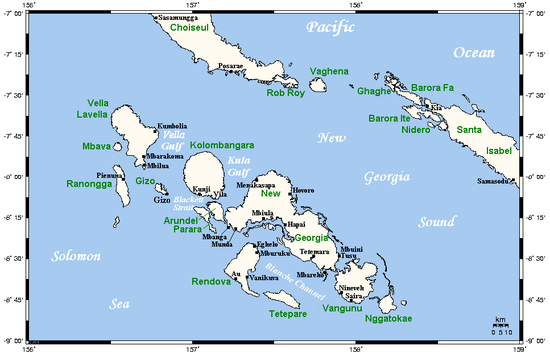New Georgia
|
| |
| Geography | |
|---|---|
| Location | Pacific Ocean |
| Coordinates | 8°15′S 157°30′E / 8.250°S 157.500°E |
| Archipelago | Solomon Islands |
| Area | 2,037 km2 (786 sq mi) |
| Length | 72 km (44.7 mi) |
| Administration | |
|
Solomon Islands | |
| province | Western Province |


New Georgia is the largest island of the Western Province of the Solomon Islands. With an area of 2,037 km2, it is the 200th largest island in the world.
Geography
New Georgia island is located in the New Georgia Group, an archipelago including most of the other larger islands in the province. About 72 km (45 miles) long, it forms part of the southern boundary of the New Georgia Sound. Kolombangara lies across the Kula Gulf to the west, Vangunu is to the east, and Rendova to the south, across the Blanche Channel.
The island is rugged and heavily forested.
History
The central part of New Georgia is the cradle of Roviana culture. A large complex of Bao megalithic shrines and other structures was developed in the 13th century AD.[1] Later, between the 15th and 17th centuries Roviana people moved over to smaller barrier islands at New Georgia with a hub in Nusa Roviana.
Through trade and head hunting expeditions, Nusa Roviana turned into the regional centre of power and trade. In the late 19th century the rule of the last chief of head hunters, Ingova, was overpowered by the British colonial army.
The Methodist Mission in New Georgia was established by Rev. John Frances Goldie in 1902. He dominated the mission and gained the loyalty of Solomon Islander members of his church.[2] The relationship with the colonial administrators of the British Solomon Island Protectorate were also fraught with difficulty, at this time due to Goldie’s effective control over the Western Solomon Islands.[2]
From 1927 to 1934 Dr Edward Sayers worked at the Methodist mission where he established a hospital at Munda and carried out fieldwork in the treatment of malaria.[3]
World War II
During Pacific War (World War II), the United States' New Georgia Campaign opened with landings on New Georgia and nearby islands on 30 June 1943. New Georgia was secured by American forces on 23 August, after weeks of difficult and bloody jungle fighting, although fighting continued on some nearby islands until October 1943.
Munda, the Japanese base on New Georgia Island, was the main objective of the assault on the island. This base was not overrun until 5 August 1943. The Japanese port at Bairoko Harbor, 13 km (eight miles) north of Munda, was not taken until 25 August.
Donald Gilbert Kennedy was a Coast watcher stationed at Segi on New Georgia during the Solomon Islands campaign during the Pacific War.[4]
Languages
The ten languages spoken on the island are from the family of New Georgia languages, a subgroup of the Northwest Solomonic languages within the Oceanic languages, a major group of the Austronesian family.
Further reading
References
- ↑ Peter J. Shepherd; Richard Walter; Takuya Nagaoka. "The Archaeology of Head-Hunting in Roviana Lagoon, New Georgia". The Journal of Polynesian Society.
- 1 2 Debra McDougall (2008). "Religious institutions as Alternative Structures in post-conflict Solomon Islands: Cases from Western Province". For State, Society and Governance in Melanesia Discussion Paper Series, 08/05, Australian National University. Retrieved 4 Oct 2011.
- ↑ Sayers , E. G. (1943) Malaria in the South Pacific with Special Reference to the Solomon Islands. New Zealand Government Printing Office
- ↑ "Coastwatcher Donald Kennedy". Axis History Forum. 2008. Retrieved 8 June 2015.
Coordinates: 8°15′S 157°30′E / 8.250°S 157.500°E